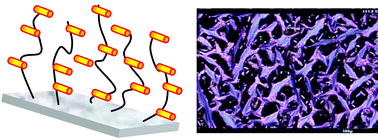Grafting liquid crystalline polymers from cellulose substrates using atom transfer radical polymerization†
Abstract
Immobilizing liquid crystalline

* Corresponding authors
a
KTH Fibre and Polymer Technology, Royal Institute of Technology, Teknikringen 56–58, SE-100 44 Stockholm, Sweden
E-mail:
mave@polymer.kth.se
Fax: +46 8 790 8283
Tel: +46 8 790 8273
b
Department of Chemistry, University of York, YO10 5DD, United Kingdom
E-mail:
iss500@york.ac.uk
Fax: +44 1904 432516
Tel: +44 1904 432607
Immobilizing liquid crystalline

 Please wait while we load your content...
Something went wrong. Try again?
Please wait while we load your content...
Something went wrong. Try again?
R. Westlund, A. Carlmark, A. Hult, E. Malmström and I. M. Saez, Soft Matter, 2007, 3, 866 DOI: 10.1039/B700630F
To request permission to reproduce material from this article, please go to the Copyright Clearance Center request page.
If you are an author contributing to an RSC publication, you do not need to request permission provided correct acknowledgement is given.
If you are the author of this article, you do not need to request permission to reproduce figures and diagrams provided correct acknowledgement is given. If you want to reproduce the whole article in a third-party publication (excluding your thesis/dissertation for which permission is not required) please go to the Copyright Clearance Center request page.
Read more about how to correctly acknowledge RSC content.
 Fetching data from CrossRef.
Fetching data from CrossRef.
This may take some time to load.
Loading related content
